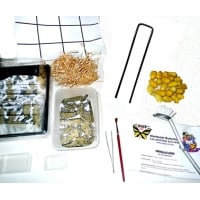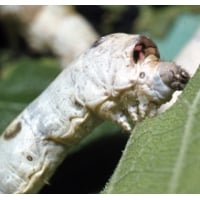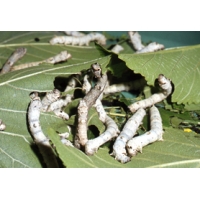SILK Yarn, Fibres, Silkworm eggs
SILKWORM REARING
Eggs are kept in a transparent box with no air holes. This keeps the atmosphere correct and enables you to see inside without having to open the box. Hatching time must depend upon when the Mulberry buds burst and as this is normally around the end of May there is a danger that the eggs might hatch too early. Therefore, keep them as cool as possible, preferably in a refrigerator (not a deep freeze). When ready for them to hatch you should incubate the eggs at about 25°C (75° F) near a light bulb or in an airing cupboard (check the temperature with a thermometer before putting the egg box in). Do not keep them where the sun could reach them. Eggs kept at incubation temperature should be in a cluster, in the plastic box, without a paper lining and never with a leaf. They will need a small amount of damp tissue in a blob in one corner, damp, not saturated. This may produce condensation which should be wiped away at least once daily, when you re-moisten the tissue. When incubated the larvae will usually all hatch within a few hours, or there is a small hatch one day, and the rest on the following day, about 10-12 days after starting incubation.
Little success is likely in trying food plants other than Mulberry. In emergency young larvae have been fed on Lettuce, Dandelion and Comfrey on hatching but they should be changed to Mulberry as soon as possible.
The Silkworm takes about six weeks from egg to cocoon depending upon temperature and food supplies. We recommend keeping young silkworms at 28°C This temperature should be dropped to 25°C from the 3rd or 4th instar. Strips of Mulberry leaf about 5mm wide can be laid over the larvae which will walk on the leaf making them easy to transfer to the rearing box. They are too small to handle but can be moved on the tip of an artist’s paint brush. Only leave the leaf strips in with the eggs for about thirty minutes, as longer than this can kill the un-hatched eggs. The first instar larvae can be kept in a transparent plastic sandwich box, lined with paper. They should be fed three or four times daily and cleaned out, with fresh paper substituted, every day. Air holes are not needed, there is more than enough air in the box Alternatively, rear in an open box or tray, but this way the food dries up and fresh leaf has to be added every hour or two. When about to change skin, the Silkworms stop feeding and rest for a day. They are shiny with a tight skin and they must not be moved off their resting place at this
As they grow, the Silkworms need more space and in the second instar, box -reared larvae should be changed to open trays, preferably trays with slats or mesh bases. In the fifth and final instar, 200 Silkworms need approximately one square metre of tray space.
Essential Points
For larger Silkworms, the strips of leaf can be cut wider until eventually whole leaves are used. Wet leaves may harm silkworms; they have to be hand dried in wet weather. Avoid keeping Silkworms in sunlight but maintain a temperature of 70° -80°F (22°-28°C). For small rearings humidity is not critical, but extremes should be avoided When a bed of dried food and litter has built up, usually after 5-7 days, transfer the Silkworms on fresh leaves into a new tray and dispose of the litter. Never let the litter remain if it is moist or if mould appears. Maintain hygiene carefully: wash with weak washing soda all trays between changes.
If any larvae die scoop up with a spoon (never with fingers) and remove litter from their immediate vicinity. Wash the spoon. Do everything to prevent disease which can spread and wipe out the entire colony. Ideally feed four to six times daily. Silkworms that lag behind in growth are usually disease carriers and should not be kept. Main causes of disease are partial starvation, overcrowding, wet food, failure to notice and remove any that die, cold, damp conditions and general lack of care. The best disinfectant for cleaning rearing quarters and instruments is 10% formaldehide. An alternative is 10% bleach.
Cocooning
Larvae about to spin become slightly transparent. They cease feeding and begin to wander. A fluid blob ejected from the tail end at this stage is a sign that cocooning time has come. Provide bunches of straw, wood wool or similar material for them to spin amongst, around the edges of the trays. Leave cocoons to harden for a week. For reeling, the cocoons must be used before the moths emerge or they can be baked in an oven at 180°F (about 80°C) for three hours, then stored. There are several colour forms of Bombyx mori cocoons; white, yellow, tangerine and gold, with intermediates. Many races exist, some of which are multi-brooded. For breeding you can leave the cocoons in place and collect up the moths when they emerge. Female moths have less hooked wings and are fatter. Keep approximately equal numbers of each sex (do not allow a surplus of males) in a paper-lined box where they will lay yellow eggs in profusion. If fertile, the eggs eventually turn grey. They are stored cool for the winter, either loose or still on the paper. A warning: disease is carried on the egg shell and eggs should not be used for breeding if there was disease amongst the larvae. Start again with fresh eggs.
Pure Silk hanks These are English reeled 20/22 Denier raw silk hanks produced at the Lullingstone Silk Farm and Worldwide Butterflies.
These fine silk hanks were reeled on the same hand reeling machine, the only one in
The size and weight not standard but the illustration shows a hank picked at random. This is a unique product!
Special temporary promotion price.
THE MINI SILK FARM
A complete outfit for rearing silkworms from egg to cocoon, and reeling your own raw silk. Everything is provided: a small batch of eggs, food for the entire life of 20 silkworms, all the rearing equipment, detailed educational documentation and instructions, and a simple reeling device.
There is even a small bag of cocoons so that you can practise reeling, and don't have to wait to rear the cocoons from the egg.

Normally Silkworms feed on Mulberry leaves. This is an uncommon tree that is not always readily available, so we are providing a substitute food, which is a powder that comes with the necessary instructions for preparing the artificial diet in the kitchen. You will have a supply of fresh food always available for the silkworms throughout their life of about a month.
The Mini Silk Farm can be bought at any time of the year. The eggs are stored in a fridge until incubation. Although rearing in summer is easier because of temperature, you can rear silkworms almost throughout the year, if you can keep them at about 25º-28ºC. Eggs supplied in winter will need to be refrigerated for 8-12 weeks before incubation.
The instructions guide you through easy rearing, preparation of the artificial diet and the reeling process. The Mini Silk Farm is fun and unusually educational.
Artificial Mulberry Diet powder for 20 Silkworms
Until now it has not been possible to rear silkworms without their natural foodplant Mulberry. Mulberry is often difficult to find but we are now able to offer a very convenient artificial diet that can be used as a substitute food, in any part of the world and at almost any time of the year, providing you can keep the silkworms at 25-28 degrees C. Eggs supplied in November/December will need to be refrigerated for 8-12 weeks before incubation.
The diet is sent as a sachet of powder that is easily prepared in the kitchen. It comes packeted to give sufficient food for the entire life of the silkworms, enough for 20 Silkworms. The powder can be kept for a year or more in a fridge. Made up diet can be refrigerated and kept for a month or more. Silkworms fed on diet will usually change to leaf if required, but if fed at first on leaf, they will not usually take to the diet. The life of a silkworm kept at the required temperature is about 5 weeks.
Artificial diet takes a lot less time and trouble than rearing on leaf. More importantly this enables rearing when Mulberry cannot be obtained. Eggs supplied in November - January will need to be refrigerated for 8-12 weeks before incubation. Rearing Silkworms is very educational and suitable for schools and families.
SILKWORM EGGS Bombyx mori WHITE COCOONS
White larvae, producing attractive pure white cocoons. Silkworms require Mulberry leaf, or artificial diet.
Instructions are not sent with the eggs but they are given at the head of the Silk section. Click on silk near the bottom of the Main Menu (top left of the screen)
In winter orders will be booked for supply in the spring. The best rearing season is May to October. Eggs supplied from October onwards are for hatching in the following year. Although there are reports of using other foodplants, the only satisfactory food plant for silkworms is Mulberry. This is sometimes found in the gardens of large houses and old parsonages. Mulberry trees are available from larger nurseries. Any Morus species is suitable: White, Black or any other Mulberry. The larvae eat a lot, so make sure you have a good supply of leaves.
NOW YOU CAN REAR SILKWORMS EVEN IF YOU HAVE NO MULBERRY! There are sachets of artificial diet that you make up in the kitchen. Each sachet is the amount needed to rear 20 silkworms throughout their life.
SILKWORM EGGS Bombyx mori WHITE COCOONS
White larvae, producing attractive pure white cocoons. Silkworms require Mulberry leaf, or artificial diet.
Instructions are not sent with the eggs but they are given at the head of the Silk section. Click on silk near the bottom of the Main Menu (top left of the screen)
In winter orders will be booked for supply in the spring. The best rearing season is May to October. Eggs supplied from October onwards are for hatching in the following year. Although there are reports of using other foodplants, the only satisfactory food plant for silkworms is Mulberry. This is sometimes found in the gardens of large houses and old parsonages. Mulberry trees are available from larger nurseries. Any Morus species is suitable: White, Black or any other Mulberry. The larvae eat a lot, so make sure you have a good supply of leaves.
NOW YOU CAN REAR SILKWORMS EVEN IF YOU HAVE NO MULBERRY! There are sachets of artificial diet that you make up in the kitchen. Each sachet is the amount needed to rear 20 silkworms throughout their life.
SILKWORM EGGS Bombyx mori WHITE COCOONS
White larvae, producing attractive pure white cocoons. Silkworms require Mulberry leaf, or artificial diet.
Instructions are not sent with the eggs but they are given at the head of the Silk section. Click on silk near the bottom of the Main Menu (top left of the screen)
In winter orders will be booked for supply in the spring. The best rearing season is May to October. Eggs supplied from October onwards are for hatching in the following year. Although there are reports of using other foodplants, the only satisfactory food plant for silkworms is Mulberry. This is sometimes found in the gardens of large houses and old parsonages. Mulberry trees are available from larger nurseries. Any Morus species is suitable: White, Black or any other Mulberry. The larvae eat a lot, so make sure you have a good supply of leaves.
NOW YOU CAN REAR SILKWORMS EVEN IF YOU HAVE NO MULBERRY! There are sachets of artificial diet that you make up in the kitchen. Each sachet is the amount needed to rear 20 silkworms throughout their life.






